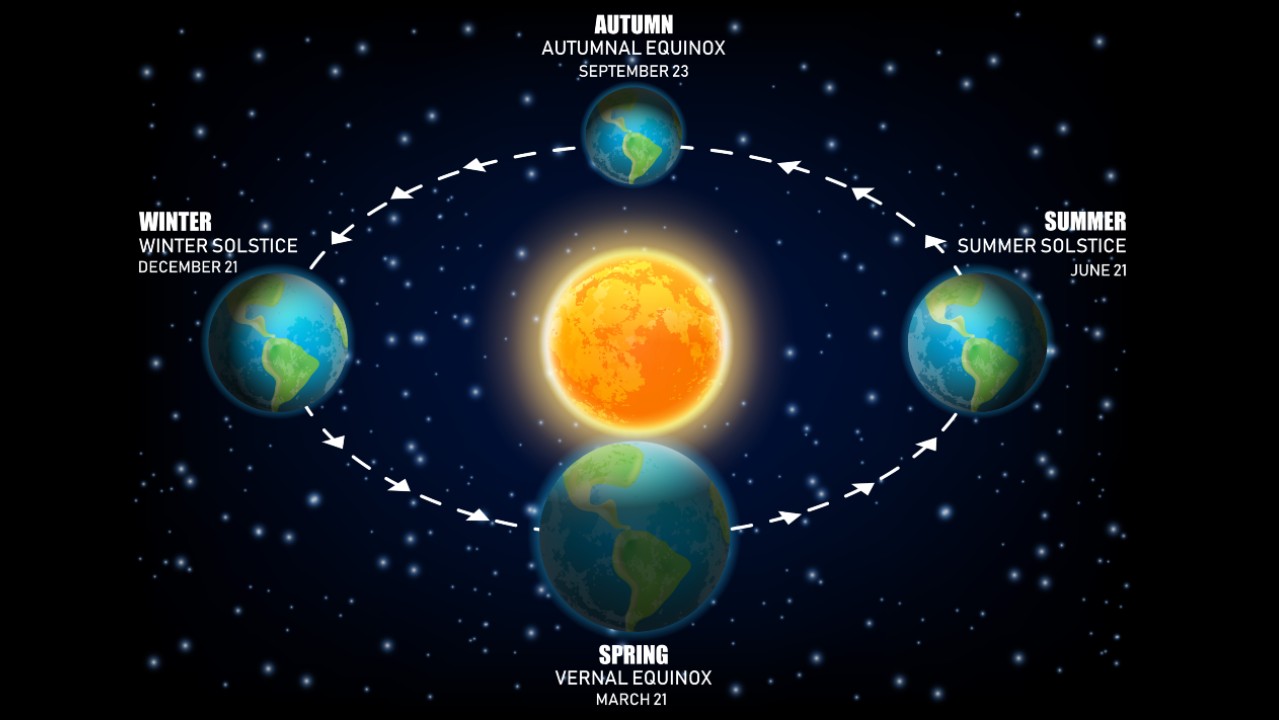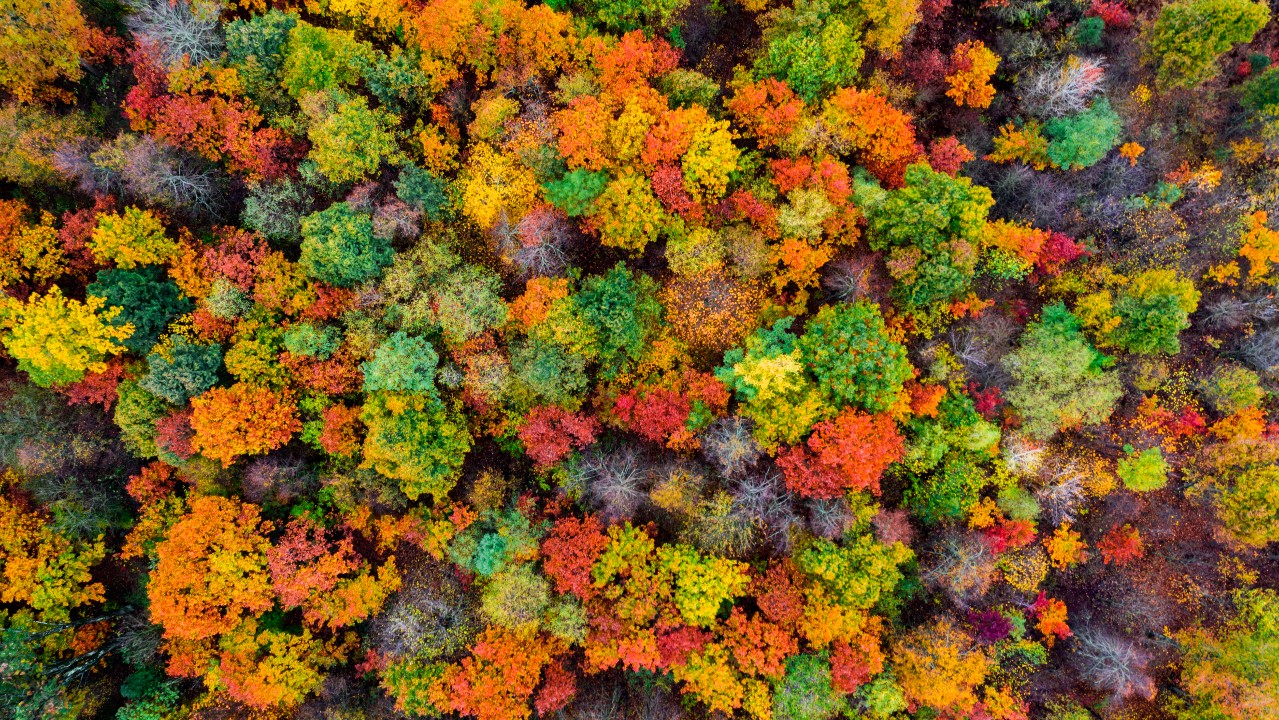Autumn: The cooling-off season
Autumn is the time of year when leaves change color, and the autumnal equinox signals that days are getting shorter.

Sandwiched between blazing summer and chilly winter, autumn is the "cooling off" season. Nighttime arrives earlier, temperatures begin to drop and most vegetative growth decreases. Animals begin to prepare for the dearth of food that generally comes during the winter, gathering supplies or traveling to warmer climates.
The cycle of seasons is caused by Earth's tilt on its axis and the planet's orbit around the sun. When the axis points toward the sun, that hemisphere experiences summer. The hemisphere tilted away from the sun experiences winter. After Earth travels a quarter of the way around the sun, the axis is pointed along the planet's path, parallel to the star.
From our perspective here on Earth, the sun travels along an imaginary line called the ecliptic, which marks the plane in which the planets orbit the sun. Another imaginary line is the celestial equator, which is a projection of Earth's equator into space. For half the year, during summer in the Northern Hemisphere, the sun appears to move along the ecliptic north of the celestial equator. During the other half of the year, it appears to be south of the celestial equator.
The exact moment when the sun appears to arrive at the intersection of the ecliptic and the celestial equator is when autumn begins. At Earth's equator, the sun is directly overhead at noon.
These moments in time are called equinoxes, and the length of daylight and nighttime are approximately the same, according to the National Maritime Museum. The word "equinox is derived from two Latin words: aequus (equal) and nox (night).
Day and night are not exactly 12 hours each. Because of the way the sun's light refracts in Earth's atmosphere, we can actually see the sun for a few minutes before its disk rises and for a few minutes after it has truly set. Thus, daylight on any given day lasts roughly six or seven minutes longer than it seemingly should.
The different definitions of autumn
The autumnal equinox is the beginning of "astronomical autumn," which ends with the start of winter. In the Northern Hemisphere, that is from around Sept. 23 to about Dec. 21, though it varies from year to year, according to the MET Office. In the Southern Hemisphere, the season runs from about March 20 to June 21.
Get the world’s most fascinating discoveries delivered straight to your inbox.
Weather forecasters and some countries define the season as "meteorological autumn" by the three months in which the weather changes. In the Northern Hemisphere, this is September, October and November. In the Southern Hemisphere, meteorological autumn occurs in March, April and May.
Falling temperatures
Autumn brings a nip in the air. How much of a change is felt depends on the location of the area on Earth. Regions near the equator experience fairly constant temperatures throughout the year, while those farther north or south experience greater variations. This is because the equator gets a consistent amount of sun. Far northern and southern regions get less sun due to the curvature of the sun, according to the Atmospheric Radiation Measurement (ARM) program.
For the continental United States, temperatures during autumn (September through November) average 55.9 degrees Fahrenheit (13.3. degrees Celsius), according to the NOAA — which is a 2.1 F (1.2 C) increase above the 20th-century average.
What's in a name?
Autumn, of course, is also known as fall, primarily in the United States. Ambivalence over the name of the third season of the year reflects its status as a relatively new concept. Many cultures only recognized two seasons, such winter and summer or winter and spring.
The period of transition between summer and winter came to be known as "harvest." "Autumn," a Latin word, first appeared in English in the late 14th century, and gradually gained on "harvest." In the 17th century, "fall" came into use, almost certainly as a poetic complement to "spring," according to the book "Folk Taxonomies in Early English" (Fairleigh Dickinson University Press, 2003) by Earl R. Anderson
Why do leaves change color?
In response to chilly temperatures and the changes in daylight, leaves stop producing green-tinted chlorophyll, which allows them to capture sunlight and make energy. Because chlorophyll is sensitive to the cold, certain weather conditions like early frosts will turn off production more quickly.
Meanwhile, orange and yellow pigments called carotenoids – also found in orange carrots – shine through the leaves' washed out green. The red color in some leaves comes from anthocyanins, which unlike carotenoids, are only produced in the fall, according to the State University of New York College of Environment. They also give color to strawberries, red apples, and plums.
But red leaves are also signal of distress. If you see leaves of a tree turning red early, in late August, the tree is most likely suffering from a fungus or perhaps a ding from a reckless driver.
Autumn in different cultures
Autumn is generally regarded as the end of the growing season. Also known as the harvest season, autumn ushers in a time of celebration for many farming cultures when they gathered in their crops.
"Autumn, or fall, is rich with different festivals which mainly celebrate the return of light, harvest, and, like spring, rebirth through death," Cristina De Rossi, an anthropologist at Barnet and Southgate College in London, told Live Science. For example, the harvest festival in the United Kingdom is a time when people give thanks for the fruits of the land and collect food to donate to those in need.
"Harvest celebrations tend to combine giving thanks with prayers for future abundance, to propitiate the god(s) and ensure successful crops," said De Rossi. Another example of this would be Thanksgiving, which is celebrated in the United States. It is a historical commemoration, but it has a spiritual dimension strongly associated with homecoming and giving praise for what has been bestowed upon us, explained De Rossi.
De Rossi also points out these celebrations as further examples of fall's ties with giving thanks and rebirth:
- The Jewish festival of Sukkot, which commemorates the time spent in exile by giving thanks.
- Halloween (All Hallows Eve) celebrations on Oct. 31 remind people of the connection with death, the spirits of those who have left this earth, and thus rebirth.
- On the following day, Christians, especially Catholics, celebrate All Hallows Day, or All Saints' Day, when people visit their departed and bring flower to their graves.
- In Mexico, the living celebrate their ancestors during the Day of the Dead on Nov. 2.
Additional resources
For more on the science of autumn check out the State University of New York College of Environmental Science and Forestry webpage on: Why Leaves Change Color and NOAA's webpage on the changing seasons.
Bibliography
- Empty Hayley Dixon, "When does Autumn really start?" The Telegraph, September 2013.
- U.S. Department of Agriculture, "Science of fall colors", Forest Service, accessed March 2022.
- NOAA, "Meteorological Versus Astronomical Seasons", September 2016.
- Danielle Wesley, "First signs of autumn", Woodland Trust, August 2019.
- Lee Mohon, "September Equinox 2021 is Coming!", NASA, September 2021.

Nola Taylor Tillman is a contributing writer for Live Science and Space.com. She loves all things space and astronomy-related, and enjoys the opportunity to learn more. She has a Bachelor’s degree in English and Astrophysics from Agnes Scott college and served as an intern at Sky & Telescope magazine. In her free time, she homeschools her four children.
- Scott DutfieldContributor




